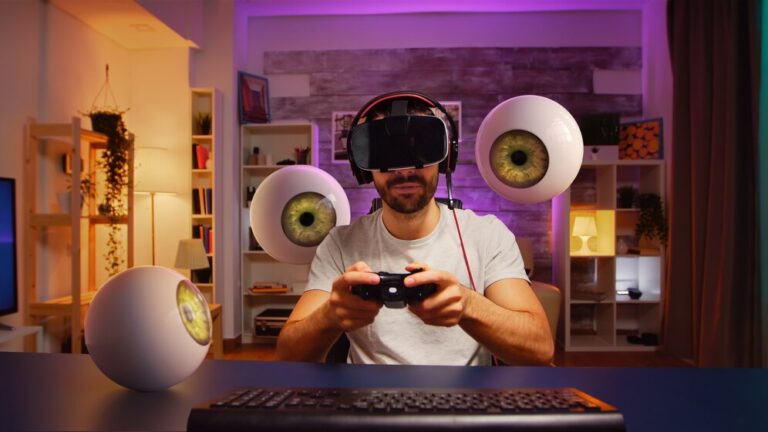PS2 AI: The Evolution of AI in PlayStation 2 Games
The gaming industry has come a long way since the early days of simple, pixelated graphics and basic gameplay mechanics. One of the key drivers behind this evolution has been the advancement of artificial intelligence (AI). AI has played a pivotal role in making games more immersive, challenging, and enjoyable. Among the many gaming consoles that have benefited from AI advancements, the PlayStation 2 (PS2) stands out as a significant milestone in gaming history.
The Evolution of Gaming Consoles
Gaming consoles have undergone a remarkable transformation over the years. From the rudimentary graphics and limited capabilities of early systems to the sophisticated, lifelike experiences offered by modern consoles, the journey has been nothing short of extraordinary. Central to this evolution is the role of AI, which has continuously pushed the boundaries of what games can achieve.
The Importance of AI in Gaming
AI is the backbone of many aspects of modern gaming. It drives the behavior of non-playable characters (NPCs), enhances the realism of in-game environments, and adjusts the difficulty to match the player’s skill level. Without AI, games would lack the depth and engagement that players have come to expect. The PS2 era marked a significant leap in the integration of AI into gaming, setting the stage for even more advanced developments in the years to come.
Overview of PlayStation 2 (PS2)
The PlayStation 2, released by Sony in 2000, quickly became one of the best-selling gaming consoles of all time. Its popularity was fueled by a combination of cutting-edge hardware, a vast library of games, and innovative features that set it apart from its competitors.
Release and Popularity
The PS2’s launch was met with widespread acclaim, and it didn’t take long for it to dominate the market. Its backward compatibility with PlayStation 1 games, DVD playback capability, and an impressive lineup of launch titles contributed to its massive success.
Key Features and Innovations
The PS2 boasted several features that were groundbreaking at the time. Its Emotion Engine processor and Graphics Synthesizer allowed for stunning graphics and complex game worlds. The console’s ability to handle AI-intensive tasks was also a major selling point, enabling developers to create more realistic and engaging experiences.
AI in PS2 Games
AI’s role in PS2 games cannot be overstated. It brought a new level of sophistication to gaming, making virtual worlds feel more alive and dynamic.
Definition and Role of AI in Gaming
In gaming, AI refers to the algorithms and techniques used to create intelligent behavior in characters and environments. This includes everything from simple pathfinding and obstacle avoidance to complex decision-making and adaptive behavior.
Early AI Implementations in PS2 Games
The PS2 era saw some of the earliest implementations of advanced AI in console gaming. Developers experimented with various AI techniques to enhance gameplay, leading to a new era of immersive and challenging games.
Iconic PS2 Games with Notable AI
Several PS2 games are renowned for their innovative use of AI, which significantly contributed to their success and lasting legacy.
Grand Theft Auto: San Andreas
“Grand Theft Auto: San Andreas” is a prime example of a game that pushed the boundaries of AI. The game featured a living, breathing open world where NPCs had their own routines and reacted dynamically to the player’s actions.
Metal Gear Solid 2: Sons of Liberty
“Metal Gear Solid 2” introduced groundbreaking stealth mechanics and enemy AI. Guards would investigate noises, remember the player’s last known location, and work together to track down intruders, creating a tense and immersive experience.
Gran Turismo 4
“Gran Turismo 4” showcased advanced AI in racing games. The AI-controlled drivers displayed realistic behavior, making strategic decisions based on the player’s actions and the race conditions.
Final Fantasy X
“Final Fantasy X” utilized AI to enhance its turn-based combat system. Enemies would adapt their strategies based on the player’s actions, providing a challenging and engaging gameplay experience.
AI Mechanics in PS2 Games
The AI mechanics in PS2 games were diverse and complex, contributing to the rich gameplay experiences that defined the console.
Pathfinding and Navigation
Pathfinding algorithms enabled NPCs to navigate game environments intelligently, avoiding obstacles and reaching their destinations efficiently. This was crucial for creating realistic and believable worlds.
Enemy Behavior and Strategy
Enemy AI in PS2 games often involved sophisticated behavior patterns and strategic decision-making. Enemies would use cover, flank the player, and cooperate with each other to provide a challenging combat experience.
Dynamic Difficulty Adjustment
Some PS2 games featured dynamic difficulty adjustment, where the AI would adapt the game’s difficulty based on the player’s performance. This ensured that players of all skill levels could enjoy a balanced and engaging experience.
Impact of AI on Gameplay Experience
AI had a profound impact on the gameplay experience in PS2 games, enhancing realism, replayability, and storytelling.
Enhanced Realism
AI brought a new level of realism to PS2 games. NPCs behaved more like real people, reacting to the player’s actions and the game environment in believable ways. This made the game worlds feel more alive and immersive.
Replayability and Engagement
AI-driven games offered higher replayability, as NPCs and enemies would react differently in each playthrough. This kept the gameplay fresh and engaging, encouraging players to revisit their favorite titles.
Adaptive Storytelling
AI also played a role in adaptive storytelling, where the game’s narrative would change based on the player’s choices and actions. This created a more personalized and immersive experience.
Development of AI for PS2
Developing AI for the PS2 posed several technical challenges, but it also led to significant innovations in AI algorithms.
Technical Challenges and Limitations
The PS2’s hardware limitations required developers to optimize their AI algorithms carefully. Balancing performance and complexity was a constant challenge, but it led to creative solutions that pushed the boundaries of what was possible.
Innovations in AI Algorithms
Despite the challenges, the PS2 era saw several innovations in AI algorithms. Developers experimented with techniques like finite state machines, behavior trees, and neural networks to create more intelligent and adaptable AI.
Case Study: AI in “Grand Theft Auto: San Andreas”
“Grand Theft Auto: San Andreas” is a standout example of AI innovation on the PS2.
AI for NPC Behavior
The game’s AI controlled the behavior of hundreds of NPCs, each with their own routines and personalities. NPCs would react to the player’s actions, engage in activities like driving and fighting, and even interact with each other.
Mission Design and Complexity
The AI also played a crucial role in the design of missions. Enemies and allies displayed intelligent behavior, making missions more challenging and engaging. The AI’s ability to adapt to different situations added depth and variety to the gameplay.
Open World Dynamics
The open world of “San Andreas” felt alive thanks to its sophisticated AI. NPCs would go about their daily lives, creating a dynamic and immersive environment that reacted to the player’s presence.
Case Study: AI in “Metal Gear Solid 2: Sons of Liberty”
“Metal Gear Solid 2” set new standards for stealth mechanics and enemy AI.
Stealth Mechanics and Enemy AI
The game’s AI was designed to create a realistic and challenging stealth experience. Guards would investigate suspicious noises, communicate with each other, and use teamwork to search for the player.
Realistic Reactions and Adaptation
Enemies in “Metal Gear Solid 2” displayed realistic reactions to the player’s actions. They would remember the player’s last known location, set traps, and adapt their strategies based on the player’s behavior.
Tactical AI Strategies
The AI employed tactical strategies, such as using cover and coordinating attacks. This made the gameplay more challenging and rewarding, requiring players to think strategically and use stealth effectively.
The Evolution of AI from PS2 to Modern Consoles
The advancements in AI that began during the PS2 era have continued to evolve, leading to even more sophisticated and immersive gaming experiences on modern consoles.
Advancements in AI Technology
Modern consoles have vastly superior hardware capabilities, allowing for more complex and realistic AI. Techniques like machine learning and procedural generation have enabled developers to create even more intelligent and dynamic game worlds.
Differences Between PS2 AI and Current Gen AI
While PS2 AI was groundbreaking for its time, modern AI is far more advanced. Current-gen AI can handle more complex behaviors, larger environments, and more realistic interactions. However, the foundational work done during the PS2 era laid the groundwork for these advancements.
Future Trends in Gaming AI
The future of gaming AI looks promising, with continued advancements in machine learning, neural networks, and procedural generation. These technologies will enable even more immersive and dynamic gaming experiences, pushing the boundaries of what is possible.
AI in Other Gaming Platforms During the PS2 Era
The PS2 wasn’t the only console to benefit from AI advancements. Other gaming platforms of the era also made significant strides in AI technology.
Comparison with Xbox and GameCube
The Xbox and GameCube also featured innovative AI, but the PS2 often led the way in terms of complexity and realism. Each platform had its strengths, but the PS2’s vast library of AI-driven games set it apart.
Cross-Platform AI Innovations
Cross-platform games often brought AI innovations to multiple consoles, allowing developers to experiment and refine their techniques. This cross-pollination of ideas helped drive the overall advancement of AI in gaming.
AI and Game Design Philosophy
The integration of AI into game design requires careful consideration of various factors, including difficulty balance, player experience, and ethical implications.
Balancing AI Difficulty
Designing AI that provides a fair and challenging experience is crucial. Developers must balance the AI’s intelligence with the player’s ability to ensure a satisfying gameplay experience.
Player Experience vs. Technical Constraints
Creating compelling AI involves balancing player expectations with the technical constraints of the platform. Developers must optimize their AI algorithms to run efficiently while still delivering a high-quality experience.
Ethical Considerations in AI Design
As AI becomes more advanced, ethical considerations come into play. Developers must consider the impact of their AI on players, including issues like fairness, transparency, and the potential for AI-driven behaviors to affect player emotions and experiences.
Community and Modding: Enhancing AI
The gaming community has played a significant role in enhancing AI in PS2 games through modding and community-driven projects.
Role of Community in AI Enhancement
Modding communities have created numerous AI enhancements for PS2 games, improving everything from enemy behavior to NPC interactions. These community-driven projects have extended the lifespan of many PS2 titles and added new layers of depth and complexity.
Notable Mods Improving AI in PS2 Games
Several notable mods have significantly improved AI in PS2 games. These mods often introduce new behaviors, enhance existing mechanics, and fix bugs, providing players with a richer and more engaging experience.
Legacy of AI in PS2 Games
The AI innovations of the PS2 era have left a lasting legacy on the gaming industry, influencing modern game development and player expectations.
Influence on Modern Game Development
The advancements in AI during the PS2 era set the stage for future developments. Many of the techniques and concepts pioneered on the PS2 have been refined and expanded upon in modern games, leading to even more sophisticated and immersive experiences.
Lasting Impact on Player Expectations
Players who grew up with the PS2 have come to expect intelligent and dynamic AI in their games. This has pushed developers to continue innovating and improving AI, ensuring that modern games meet the high standards set by their predecessors.
Conclusion
The PlayStation 2 era was a pivotal time for AI in gaming. The advancements made during this period laid the foundation for the sophisticated AI systems we see in modern games. From the realistic NPC behaviors in “Grand Theft Auto: San Andreas” to the tactical enemy AI in “Metal Gear Solid 2,” the PS2’s AI innovations have left a lasting legacy on the gaming industry. As we look to the future, it’s clear that AI will continue to play a crucial role in shaping the next generation of gaming experiences.
FAQs
What was the most advanced AI in a PS2 game?
One of the most advanced AIs in a PS2 game can be found in “Metal Gear Solid 2: Sons of Liberty,” which featured realistic enemy behaviors and sophisticated stealth mechanics.
How did AI in PS2 games differ from earlier consoles?
AI in PS2 games was more complex and realistic compared to earlier consoles, thanks to the PS2’s more powerful hardware and the development of new AI techniques.
Can modern AI techniques be applied to PS2 games?
While modern AI techniques are often too resource-intensive for the PS2’s hardware, some simplified versions can be applied through modding and optimization.
How did AI impact the difficulty of PS2 games?
AI in PS2 games often made them more challenging and engaging by providing intelligent enemy behaviors and adaptive difficulty, enhancing the overall gameplay experience.
Are there any PS2 games known for bad AI?
Some PS2 games had less sophisticated AI, leading to predictable or unintelligent behaviors. However, the overall trend during the PS2 era was toward more advanced and realistic AI.







